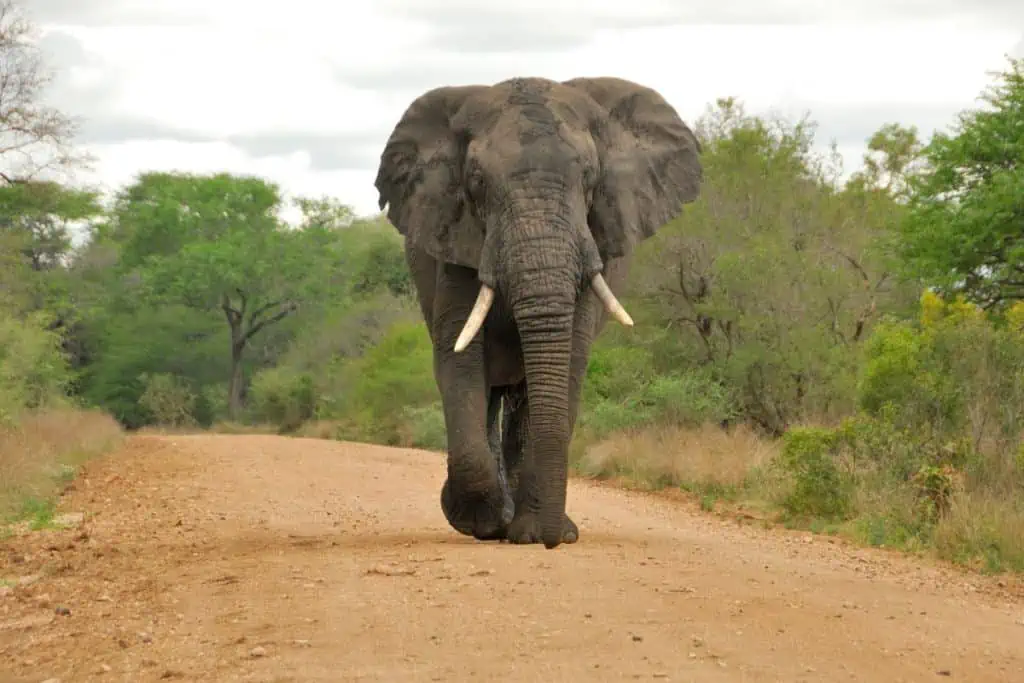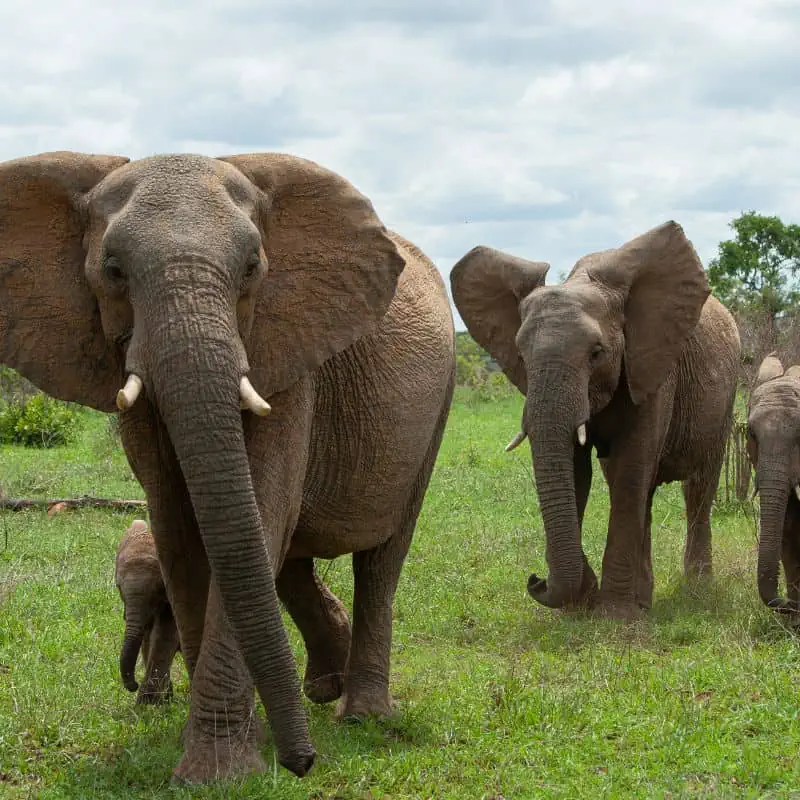The African bush elephant, also known as the African Savanna elephant, is the largest land mammal in the world. It is the largest among the three elephant species and usually inhabits forests, grasslands, wetlands, and woodlands. They are found everywhere in the sub-Saharan African savannas.
The African bush elephant is a herbivore and spends most of the day eating leaves, bark, and fruit and foraging through just about anything they feel like. An adult African bush elephant can grow up to 24 feet in length and 13 feet in height. In addition, to its giant size, the African bush elephant can weigh close to 11 tons or close to 10,000 kilograms.
This article will help you differentiate the African bush elephant from other species of elephants by discussing ten interesting facts about it.

- 10 Facts About African Bush Elephant
- 1. African Bush Elephants Can Grow to 4 Meters
- 2. They Have Female Dominated Herds
- 3. Their Lifespan Is Close to a Human’s
- 4. They Enjoy Swimming and Snorkeling
- 5. African Bush Elephants Are Intelligent Too
- 6. Their Ears Are More Impressive Than Ours
- 7. They Possess a Strong Sense of Smell
- 8. African Bush Elephants are Faster Than Us
- 9. Their Trunks are Multi-Talented
- 10. They are an Endangered Species Now
- Final Thoughts About the African Bush Elephants
- FAQs
10 Facts About African Bush Elephant
African bush elephants stand out in the animal kingdom owing to their immense size, but that’s only one of the many things that make them so interesting.
Here are ten facts about the African bush elephants that you might now know:
1. African Bush Elephants Can Grow to 4 Meters
They are by far the largest terrestrial animals.
A female elephant, also known as a cow, can grow up to 2.2-2.6 meters tall and weigh close to 2000-3000 kg.
A male elephant, known as a bull, can reach 3.2-4 meters tall at the shoulder and weigh 4700-6100 kg.
The shape of an African bush elephant’s back is concave, unlike other elephant species. This shape contributes to the generous size of the African bush elephant.
The giant recorded African bush elephant weighed 10,400 kg while standing at an unbelievable height of 3.96 meters.
2. They Have Female Dominated Herds
Many species worldwide, such as lions, killer whales, meerkats, and lemurs, have matriarchal herds. An African bush elephant herd is no different.
Adult male elephants spend most of their lives alone, separate from the herd, only returning during mating season.
Calves are kept regardless of gender and allowed to socialize within the herd. Although female calves are more emotionally connected to the herd.
After an average of eight years, the male calves are sent away to live alone away from the herd.

3. Their Lifespan Is Close to a Human’s
An African bush elephant can live almost till the average lifespan of a human.
They can live up to 70 years, which is a long time for a land animal. A lion can only live up to 16 years compared to an elephant.
Some species found in the ocean are the only other non-human mammal species that compare to the lifespan of an African bush elephant.
This elephant species is the second longest-living land mammal behind us humans.
4. They Enjoy Swimming and Snorkeling
The African bush elephants are great swimmers, like many other animal species. Like most mammals found on the planet, they are natural-born swimmers.
Although swimming is not where they stop, with the help of their trunk, they can go wholly underwater and submerge, breathing with the help of their trunk. Their trunk helps them swim for hours without any trouble.
It is almost impossible for an African bush elephant to drown due to their size, so it can easily float in water and rest when they get tired of swimming.
5. African Bush Elephants Are Intelligent Too
The African bush elephant has the largest brain compared to any other land animal. They have thrice as many neurons as humans.
These neurons control the elephant’s giant body and assist in its management. Elephants are only one of the few mammals that can recognize their reflection in water or a mirror.
They have been seen to create tools from materials in nature. It isn’t limited to this species, but it is impressive.
6. Their Ears Are More Impressive Than Ours
While African bush elephants use mud baths and submerge themselves in the water to fight off the African heat, their ears also assist in cooling them down.
The skin on the ear of an African bush elephant is really thin. In addition, the tiny blood vessels found in the ear cool down the African bush elephant.
The ears can also be used to communicate with other elephants. An African bush elephant can hear another elephant’s call on an average of 4 kilometers away.
7. They Possess a Strong Sense of Smell
An African bush elephant has a strong sense of smell which they use to find water in sub-Saharan Africa.
An elephant shakes its trunk to detect a particular odor or odorant molecule. If it notices moisture in the air, it will locate where it originated and move in that direction.
A crucial adaptation for surviving in the desert is the capacity to detect water via smell.
However, scientists have long researched the trunk of an elephant. Most scientists agree that an elephant can smell more than just water.
It has a strong enough smell to pick up the scent of grass or any animal.
8. African Bush Elephants are Faster Than Us
Judging by the size of an African bush elephant, it wouldn’t be wrong to assume that they aren’t fast.
However, We have news for you; an African bush elephant can run close to 40 kilometers per hour.
When compared, this is faster than the average speed of a human, which is just 13 kilometers per hour. They take longer strides to move quicker and divide their weight.
While they can’t run as fast as predators such as lions or leopards, that isn’t a problem; African Bush elephants aren’t vulnerable like their other prey.

9. Their Trunks are Multi-Talented
The trunk of an African bush elephant isn’t only helpful in smelling or swimming, but it’s also a competent tool for self-defense.
The famous cry of an African bush elephant is used as a self-defense mechanism with which it tries to scare off the predator and alarm any nearby herd for rescue.
If the herd is close, it usually hears the call for help and assists the elephant under attack.
10. They are an Endangered Species Now
The African bush elephant has been declared endangered due to consistent poaching and habitat loss.
Human-elephant conflict is another big reason, as killings of elephants often happen in retaliation after elephants trample crops and eat from food stores.
The species is essential to keep the balance in nature. African bush elephants reduce tree densities in savannas that protect numerous other plant species.
WWF (World Wildlife Fund) has been protecting the African bush elephant population by easing the human-elephant conflict, research and monitoring, and fighting illegal wildlife trade.
Final Thoughts About the African Bush Elephants
The African bush elephant is a fascinating species that stands out not only in terms of its size but also with how it can snorkel and how its herd is matriarchal.
Everything the African bush elephants do is nothing short of magnificent.
FAQs
Do the Tusks of an African Bush Elephant Function Like Teeth?
Unlike other species of elephants, both male and female African bush elephants have tusks. Their tusks function like incisors but can be used for many different purposes, such as foraging, digging, and protecting themselves from other predators.
Why Is the Head of an African Bush Elephant Heavy?
The head of an African bush elephant can weigh up to 3-4 tons due to its tusks and trunks. That is approximately a quarter of the size of a fully-grown elephant.
What Habitats Can an African Bush Elephant Survive In?
The African bush elephants move between various environments— woodlands to mountain slopes, dry grasslands, flooded meadows, and forests. They live in semi-desert and desert locations in Mali and Namibia as well.
